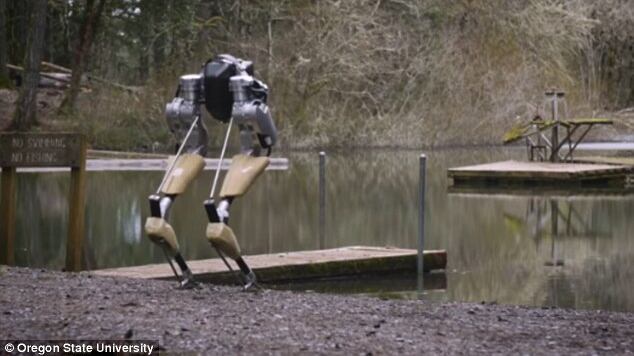"We don't understand feet yet," says Jonathan Hurst. He doesn't seem altogether put out by this. After all: no one anywhere understands feet.
That's why his robot doesn't really have them. But feet or no feet, a little robot like Hurst's Oregon-designed robot, Cassie, may soon be your mailman, your personal bellhop, and your bomb-sniffing dog.
At TechfestNW March 24, the Oregon State University mechanical engineering professor has just finished describing a robot that's perhaps more adroit than any other robot in the world, the first to solve a problem that's been dogging robotics engineers since the beginnings of the field. The main problem? They always fall down. Put a pebble in their path and they biff it. If most robots were a little better at walking, they'd be drunk.
But when Hurst describes describing why his robot Cassie is able to walk where no other robot can walk. It turns out he's taking his cues from a dead fish.
Playing a video of a fish that appears to be swimming upstream, Hurst then pauses to note that the seemingly swimming fish happens to be a corpse. The dynamics of the fish itself, the way it flops in a current, keeps even a dead fish blithely flapping away against the current.
"The dead fish swims upstream," Hurst says, as the corpse flops in water onscreen. "Fluid dynamics make the fish swim passively."
A striding human or dog also operates as a dynamical system that keeps your body stable, kind of like a complicated version of a pendulum swinging back and forth across equilibrium.
That is to say, it's not because humans are so smart that we don't fall down; it's that we're designed not to. All Hurst and his team had to do is measure the periodic forces in play when a human walks, and they were able to replicate that slight swagger in robot form. Although, to maintain that natural pendular momentum, the simplest version of OSU's robot sort of likes to jog in place a bit.
That awkward jog seems work out for the robot, however. To demonstrate the stability of their robot, one of Hurst's engineers kicks it a little, causing the robot do do what a human would do: it buckles a little, and then it recovers. It's only amazing if you've seen videos of countless other robots failing.
"If robots go where people go, it'll change economies," he says. "It will impact things as much as the car. Prosthetic legs will improve, wheelchairs will be a thing of the past. In a fire, it's a difficult decision whether to send in firefighters. but sending in a fireproof robot is no big deal."
Within eight years, Hurst hopes to have these little robots on pilot programs out in the streets, delivering mail packages.
The goal, he says, is to exceed animal performance, something no one has yet accomplished. While materials and computing power are not problems, Hurst says, his team hasn't yet figured out how to create precise control of where his little goosestepping robot steps; and so even if the balance of the robot is excellent, steep staircases and deep potholes might still be a problem.
And after that, they're going to have to figure out what feet are good for. For now, they don't really fit into the model.<

